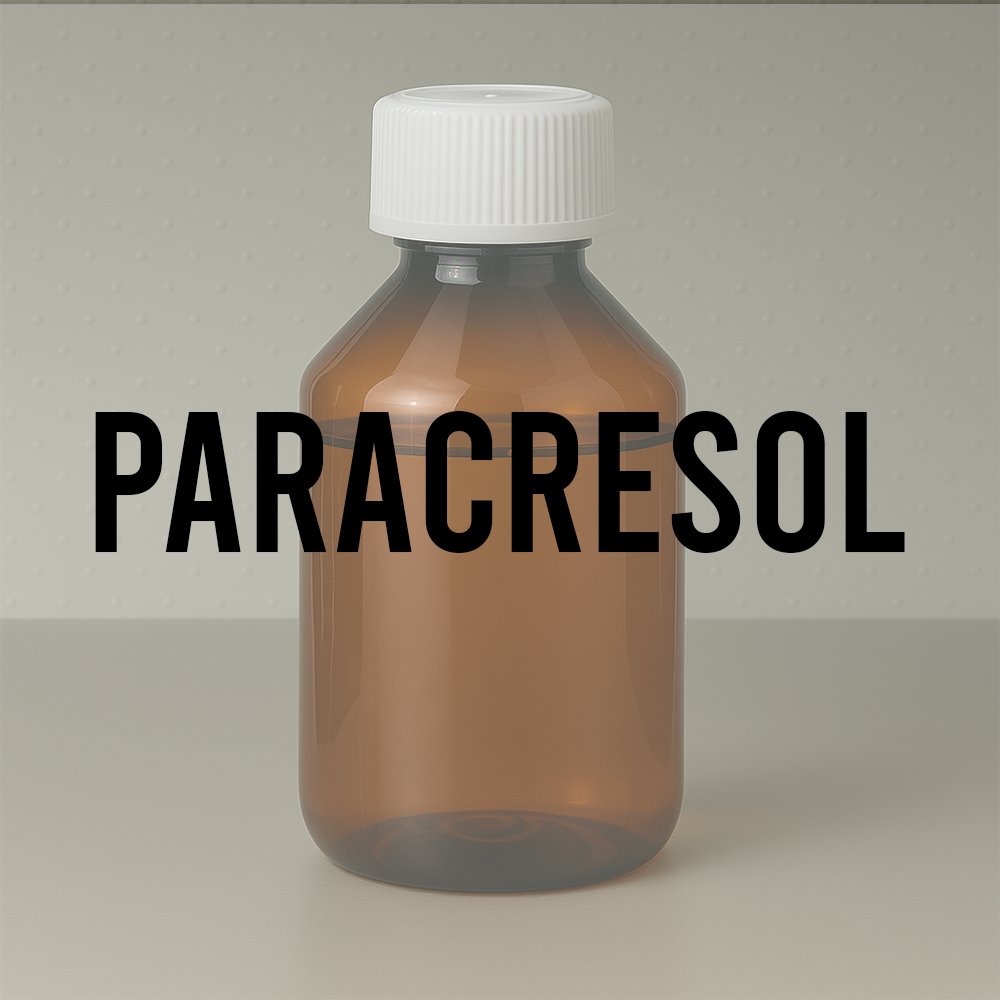Technical Ingredient Overview
🔎 Chemical Name: 4-Methylphenol
🧪 Synonyms: p-Cresol, para-Cresol, 1-hydroxy-4-methylbenzene, p-cresylic acid, 4-cresol
📂 CAS N°: 106-44-5
📘 FEMA: 2337
⚖️ MW: 108.14 g/mol
🧴 Appearance: Colourless to pale-yellow crystals; m.p. 35.5 °C, b.p. 201.9 °C
📝 Odor Type: Phenolic, animalic-floral
📈 Odor Strength: Very high
👃🏼 Odor Profile: Horse-stable, narcissus, mimosa, leathery, medicinal
🌿 Natural Occurrence: Trace in ylang-ylang, jasmine absolute, and castoreum
Main perfumery uses
≤ 0.05 % to add “dirty-floral” realism to narcissus, tuberose, jasmine
≤ 0.1 % for smoky leather / oud bases
Precursor of p-cresyl acetate and p-cresyl phenylacetate
Synergistic with Indole and Castoreum absolute
Olfactory Performance
Intensity & tenacity: extremely powerful; ~ 20 h on blotter at 10 % in DPG
Fixative role: low vapour pressure; persists in the dry-down.
Historical Background
Tar-acid beginnings (1832 – 1870s).
Carl Reichenbach’s 1832 isolation of creosote exposed the antiseptic strength of phenolic tar acids, while Friedlieb Runge’s 1834 extraction of crude phenol opened systematic coal-tar research (Reichenbach, 1832; Runge, 1834). In the late 1860s Friedrich Beilstein and Alexander Kuhlberg repeatedly fractionated the “cresylic-acid” cut (190–210 °C), crystallising three methylphenol isomers and proving their structures—thus defining 4-methylphenol (para-cresol) (Fiege, 2000).
Synthetic foundations & disinfectant boom (1877 – 1890s).
Friedel and Crafts’ 1877 work on Lewis-acid alkylation suggested a direct route from phenol to cresols (Friedel & Crafts, 1877). Public-health crises soon created a mass market: during the 1889 cholera outbreak Gustav Raupenstrauch launched Lysol®, a cresol-soap disinfectant, and in 1892 Hugo Engler with Heinrich Dieckhoff devised fully water-soluble cresol soaps for hospital use (Lysol, 2025; Engler & Dieckhoff, 1892).
Industrial scale-up (1900 – 1940s).
Coke-oven by-product plants recovered cresols by the tonne; the 1920s introduced the toluene-sulfonation / alkali-fusion route, converting p-toluenesulfonate into high-purity para-cresol and reducing reliance on coal tar (Fiege, 2000).
Antioxidant era & modern processes (1947 – present).
Eastman Kodak’s 1947 patent for 2,6-di-tert-butyl-4-methylphenol (BHT) created vast demand, as BHT forms in a single step from para-cresol (USDA, 2002). A 1961 hydrodealkylation patent linked cresol output to phenol manufacture (U.S. Patent 2,998,457, 1961). The 1990s introduced zeolite-mediated selective methylation of phenol and cymene-cresol oxidation, boosting para-selectivity and cutting waste (Fiege, 2000). Current R&D explores renewable aromatics and circular-carbon feedstocks, yet the chemistry remains rooted in its 19th-century tar-acid origins.
Perfumery legacy.
Despite bulk-chemical status, para-cresol remains prized in niche fragrance: Arctander (1969) highlighted its “dry, medicinal-leathery” nuance that vivifies narcissus, tuberose, jasmine and classic leather bases even below 0.05 %.
Industrial & Technical Uses
Feedstock for the antioxidant BHT (Fiege, 2000).
Intermediate for pharmaceuticals (bupranolol, tolbutamide).
Monomer for phenolic resins and UV absorbers.
Active phenolic in disinfectant soaps.
Regulatory & Safety Snapshot
IFRA 51 (2023): 0.0017 – 0.005 % max in finished product (category-dependent); no limit for Category 12 (IFRA, 2023).
GHS / CLP (EU): Acute Tox 3 (H301, H311), Skin Corr 1B (H314), Eye Dam 1 (H318), Aquatic Chronic 3 (H412) (Sigma-Aldrich, 2024).
EU Cosmetics Regulation: not specifically listed; compliance via IFRA + Reg. (EC) 1223/2009 safety assessment.
FEMA GRAS 2337: flavour use permitted under CFR §172.515 (FEMA, 2024).
LD₅₀ (rat, oral): ~ 207 mg kg⁻¹; corrosive—use gloves and local exhaust ventilation (Sigma-Aldrich, 2024).
Additional Notes
Trace para-cresol contributes warmth to ylang-ylang and castoreum extracts; gentler effects can be achieved with its acetate and phenylacetate esters.
References
Arctander, S. (1969). Perfume and flavor chemicals (Vol. II). Author.
ATSDR. (2023). Toxicological profile for cresols. U.S. Department of Health & Human Services.
Engler, C., & Dieckhoff, H. (1892). Soluble cresol-soap antiseptics. Archiv für Hygiene.
FEMA. (2024). FEMA GRAS 2337 – p-Cresol. Flavor & Extract Manufacturers Association.
Fiege, H. (2000). Cresols and xylenols. In Ullmann’s encyclopedia of industrial chemistry (pp. 419-461). Wiley-VCH.
Friedel, C., & Crafts, J. M. (1877). Comptes Rendus, 84, 1392-1450.
IFRA. (2023). IFRA standard on p-Cresol (Amendment 51). International Fragrance Association.
Lysol. (2025, May 17). In Wikipedia. https://en.wikipedia.org/wiki/Lysol
PubChem. (2025). p-Cresol (CID 2879). National Library of Medicine. Retrieved 17 May 2025.
Sigma-Aldrich. (2024). Safety data sheet: p-Cresol. Merck KGaA.
Reichenbach, C. (1832). De Aquae Binelli et Kreosoti virtute styptica (Doctoral dissertation).
Runge, F. F. (1834). Coal-tar distillation products. Annalen der Physik und Chemie.
U.S. Patent 2,998,457. (1961). Production of phenols.
USDA. (2002). BHT technical review (citing Eastman Kodak patent, 1947).







